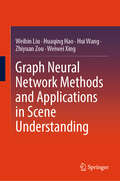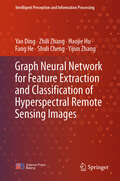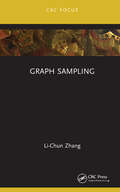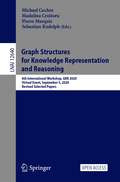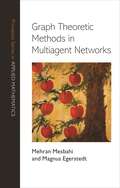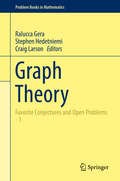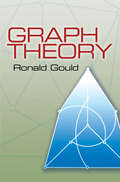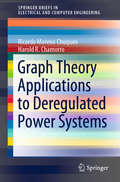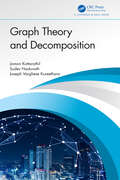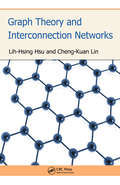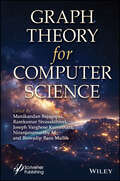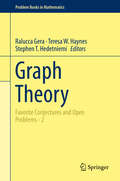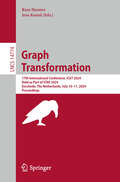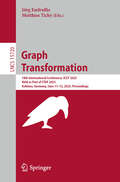- Table View
- List View
Graph Neural Network Methods and Applications in Scene Understanding
by Weibin Liu Weiwei Xing Hui Wang Huaqing Hao Zhiyuan ZouThe book focuses on graph neural network methods and applications for scene understanding. Graph Neural Network is an important method for graph-structured data processing, which has strong capability of graph data learning and structural feature extraction. Scene understanding is one of the research focuses in computer vision and image processing, which realizes semantic segmentation and object recognition of image or video. In this book, the algorithm, system design and performance evaluation of scene understanding based on graph neural networks have been studied. First, the book elaborates the background and basic concepts of graph neural network and scene understanding, then introduces the operation mechanism and key methodological foundations of graph neural network. The book then comprehensively explores the implementation and architectural design of graph neural networks for scene understanding tasks, including scene parsing, human parsing, and video object segmentation. The aim of this book is to provide timely coverage of the latest advances and developments in graph neural networks and their applications to scene understanding, particularly for readers interested in research and technological innovation in machine learning, graph neural networks and computer vision. Features of the book include self-supervised feature fusion based graph convolutional network is designed for scene parsing, structure-property based graph representation learning is developed for human parsing, dynamic graph convolutional network based on multi-label learning is designed for human parsing, and graph construction and graph neural network with transformer are proposed for video object segmentation.
Graph Neural Network for Feature Extraction and Classification of Hyperspectral Remote Sensing Images (Intelligent Perception and Information Processing)
by Yijun Zhang Yao Ding Zhili Zhang Haojie Hu Fang He Shuli ChengThis book deals with hyperspectral image classification using graph neural network methods, focusing on classification model designing, graph information dissemination, and graph construction. In the book, various graph neural network based classifiers have been proposed for hyperspectral image classification to improve the classification accuracy. This book has promoted the application of graph neural network in hyperspectral image classification, providing reference for remote sensing image processing. It will be a useful reference for researchers in remote sensing image processing and image neural network design.
Graph Neural Network for Hyperspectral Image Clustering (Intelligent Perception and Information Processing)
by Jie Feng Yao Ding Zhili Zhang Haojie Hu Renxiang Guan Zhiyong LvThis book investigates detailed hyperspectral image clustering using graph neural network (graph learning) methods, focusing on the overall construction of the model, design of self-supervised methods, image pre-processing, and feature extraction of graph information. Multiple graph neural network-based clustering methods for hyperspectral images are proposed, effectively improving the clustering accuracy of hyperspectral images and taking an important step towards the practical application of hyperspectral images. This book is innovative in content and emphasizes the integration of theory with practice, which can be used as a reference book for graduate students, senior undergraduate students, researchers, and engineering technicians in related majors such as electronic information engineering, computer application technology, automation, instrument science and technology, remote sensing.
Graph Neural Networks: Essentials and Use Cases
by Pethuru Raj Chelliah Usha Sakthivel Susila Nagarajan Pawan Whig Nikhitha YathirajuThis book explains the technologies and tools that underpin GNNs, offering a clear and practical guide to their industrial applications and use cases. AI engineers, data scientists, and researchers in AI and graph theory will find detailed insights into the latest trends and innovations driving this dynamic field. With practical chapters demonstrating how GNNs are reshaping various industry verticals—and how they complement advances in generative, agentic, and physical AI—this book is an essential resource for understanding and leveraging their potential. The neural network paradigm has surged in popularity for its ability to uncover hidden patterns within vast datasets. This transformative technology has spurred global innovations, particularly through the evolution of deep neural networks (DNNs). Convolutional neural networks (CNNs) have revolutionized computer vision, while recurrent neural networks (RNNs) and their advanced variants have automated natural language processing tasks such as speech recognition, translation, and content generation. Traditional DNNs primarily handle Euclidean data, yet many real-world problems involve non-Euclidean data—complex relationships and interactions naturally represented as graphs. This challenge has driven the rise of graph neural networks (GNNs), an approach that extends deep learning into new domains. GNNs are powerful models designed to work with graph-structured data, where nodes represent individual data points and edges denote the relationships between them. Several variants have emerged: Graph Convolutional Networks (GCNs): These networks learn from a node&’s local neighborhood by aggregating information from adjacent nodes, updating the node&’s representation in the process. Graph Attentional Networks (GATs): By incorporating attention mechanisms, GATs focus on the most relevant neighbors during aggregation, enhancing model performance. Graph Recurrent Networks (GRNs): These networks combine principles from RNNs with graph structures to capture dynamic relationships within the data. GNNs are applied in a variety of advanced use cases, including node classification, link prediction, graph clustering, anomaly detection, recommendation systems, and also in natural language processing and computer vision. They help forecast traffic patterns, analyze molecular structures, verify programs, predict social influence, model electronic health records, and map brain networks.
Graph Polynomials (Discrete Mathematics and Its Applications)
by Yongtang Shi; Matthias Dehmer; Xueliang Li; Ivan GutmanThis book covers both theoretical and practical results for graph polynomials. Graph polynomials have been developed for measuring combinatorial graph invariants and for characterizing graphs. Various problems in pure and applied graph theory or discrete mathematics can be treated and solved efficiently by using graph polynomials. Graph polynomials have been proven useful areas such as discrete mathematics, engineering, information sciences, mathematical chemistry and related disciplines.
Graph Sampling
by Li-Chun ZhangMany technological, socio-economic, environmental, biomedical phenomena exhibit an underlying graph structure. Valued graph allows one to incorporate the connections or links among the population units in addition. The links may provide effectively access to the part of population that is the primary target, which is the case for many unconventional sampling methods, such as indirect, network, line-intercept or adaptive cluster sampling. Or, one may be interested in the structure of the connections, in terms of the corresponding graph properties or parameters, such as when various breadth- or depth-first non-exhaustive search algorithms are applied to obtain compressed views of large often dynamic graphs. Graph sampling provides a statistical approach to study real graphs from either of these perspectives. It is based on exploring the variation over all possible sample graphs (or subgraphs) which can be taken from the given population graph, by means of the relevant known sampling probabilities. The resulting design-based inference is valid whatever the unknown properties of the given real graphs. One-of-a-kind treatise of multidisciplinary topics relevant to statistics, mathematics and data science. Probabilistic treatment of breadth-first and depth-first non-exhaustive search algorithms in graphs. Presenting cutting-edge theory and methods based on latest research. Pathfinding for future research on sampling from real graphs. Graph Sampling can primarily be used as a resource for researchers working with sampling or graph problems, and as the basis of an advanced course for post-graduate students in statistics, mathematics and data science.
Graph Spectra for Complex Networks
by Piet Van MieghemAnalyzing the behavior of complex networks is an important element in the design of new man-made structures such as communication systems and biologically engineered molecules. Because any complex network can be represented by a graph, and therefore in turn by a matrix, graph theory has become a powerful tool in the investigation of network performance. This self-contained 2010 book provides a concise introduction to the theory of graph spectra and its applications to the study of complex networks. Covering a range of types of graphs and topics important to the analysis of complex systems, this guide provides the mathematical foundation needed to understand and apply spectral insight to real-world systems. In particular, the general properties of both the adjacency and Laplacian spectrum of graphs are derived and applied to complex networks. An ideal resource for researchers and students in communications networking as well as in physics and mathematics.
Graph Structure and Monadic Second-Order Logic
by Bruno Courcelle Joost EngelfrietThe study of graph structure has advanced in recent years with great strides: finite graphs can be described algebraically, enabling them to be constructed out of more basic elements. Separately the properties of graphs can be studied in a logical language called monadic second-order logic. In this book, these two features of graph structure are brought together for the first time in a presentation that unifies and synthesizes research over the last 25 years. The authors not only provide a thorough description of the theory, but also detail its applications, on the one hand to the construction of graph algorithms, and, on the other to the extension of formal language theory to finite graphs. Consequently the book will be of interest to graduate students and researchers in graph theory, finite model theory, formal language theory, and complexity theory.
Graph Structures for Knowledge Representation and Reasoning: 6th International Workshop, GKR 2020, Virtual Event, September 5, 2020, Revised Selected Papers (Lecture Notes in Computer Science #12640)
by Madalina Croitoru Pierre Marquis Sebastian Rudolph Michael CochezThis open access book constitutes the thoroughly refereed post-conference proceedings of the 6th International Workshop on Graph Structures for Knowledge Representation and Reasoning, GKR 2020, held virtually in September 2020, associated with ECAI 2020, the 24th European Conference on Artificial Intelligence.The 7 revised full papers presented together with 2 invited contributions were reviewed and selected from 9 submissions. The contributions address various issues for knowledge representation and reasoning and the common graph-theoretic background, which allows to bridge the gap between the different communities.
Graph Theoretic Methods in Multiagent Networks (Princeton Series in Applied Mathematics #33)
by Mehran Mesbahi Magnus EgerstedtThis accessible book provides an introduction to the analysis and design of dynamic multiagent networks. Such networks are of great interest in a wide range of areas in science and engineering, including: mobile sensor networks, distributed robotics such as formation flying and swarming, quantum networks, networked economics, biological synchronization, and social networks. Focusing on graph theoretic methods for the analysis and synthesis of dynamic multiagent networks, the book presents a powerful new formalism and set of tools for networked systems. The book's three sections look at foundations, multiagent networks, and networks as systems. The authors give an overview of important ideas from graph theory, followed by a detailed account of the agreement protocol and its various extensions, including the behavior of the protocol over undirected, directed, switching, and random networks. They cover topics such as formation control, coverage, distributed estimation, social networks, and games over networks. And they explore intriguing aspects of viewing networks as systems, by making these networks amenable to control-theoretic analysis and automatic synthesis, by monitoring their dynamic evolution, and by examining higher-order interaction models in terms of simplicial complexes and their applications. The book will interest graduate students working in systems and control, as well as in computer science and robotics. It will be a standard reference for researchers seeking a self-contained account of system-theoretic aspects of multiagent networks and their wide-ranging applications. This book has been adopted as a textbook at the following universities: ? University of Stuttgart, Germany Royal Institute of Technology, Sweden Johannes Kepler University, Austria Georgia Tech, USA University of Washington, USA Ohio University, USA
Graph Theory
by Ralucca Gera Stephen Hedetniemi Craig LarsonThis is the first in a series of volumes, which provide an extensive overview of conjectures and open problems in graph theory. The readership of each volume is geared toward graduate students who may be searching for research ideas. However, the well-established mathematician will find the overall exposition engaging and enlightening. Each chapter, presented in a story-telling style, includes more than a simple collection of results on a particular topic. Each contribution conveys the history, evolution, and techniques used to solve the authors' favorite conjectures and open problems, enhancing the reader's overall comprehension and enthusiasm. The editors were inspired to create these volumes by the popular and well attended special sessions, entitled "My Favorite Graph Theory Conjectures," which were held at the winter AMS/MAA Joint Meeting in Boston (January, 2012), the SIAM Conference on Discrete Mathematics in Halifax (June,2012) and the winter AMS/MAA Joint meeting in Baltimore(January, 2014). In an effort to aid in the creation and dissemination of open problems, which is crucial to the growth and development of a field, the editors requested the speakers, as well as notable experts in graph theory, to contribute to these volumes.
Graph Theory
by Ronald GouldThis introduction to graph theory focuses on well-established topics, covering primary techniques and including both algorithmic and theoretical problems. The algorithms are presented with a minimum of advanced data structures and programming details. This thoroughly corrected 1988 edition provides insights to computer scientists as well as advanced undergraduates and graduate students of topology, algebra, and matrix theory. Fundamental concepts and notation and elementary properties and operations are the first subjects, followed by examinations of paths and searching, trees, and networks. Subsequent chapters explore cycles and circuits, planarity, matchings, and independence. The text concludes with considerations of special topics and applications and extremal theory. Exercises appear throughout the text.
Graph Theory Applications to Deregulated Power Systems (SpringerBriefs in Electrical and Computer Engineering)
by Ricardo Moreno Chuquen Harold R. ChamorroThis book provides a detailed description of network science concepts applied to power systems and electricity markets, offering an appropriate blend of theoretical background and practical applications for operation and power system planning. It discusses an approach to understanding power systems from a network science perspective using the direct recognition of the interconnectivity provided by the transmission system. Further, it explores the network properties in detail and characterizes them as a tool for online and offline applications for power system operation. The book includes an in-depth explanation of electricity markets problems that can be addressed from a graph theory perspective. It is intended for advanced undergraduate and graduate students in the fields of electric energy systems, operations research, management science and economics. Practitioners in the electric energy sector also benefit from the concepts and techniques presented here.
Graph Theory and Decomposition
by Joseph Varghese Kureethara Jomon Kottarathil Sudev NaduvathThe book Graph Theory and Decomposition covers major areas of the decomposition of graphs. It is a three-part reference book with nine chapters that is aimed at enthusiasts as well as research scholars. It comprehends historical evolution and basic terminologies, and it deliberates on decompositions into cyclic graphs, such as cycle, digraph, and K4-e decompositions. In addition to determining the pendant number of graphs, it has a discourse on decomposing a graph into acyclic graphs like general tree, path, and star decompositions. It summarises another recently developed decomposition technique, which decomposes the given graph into multiple types of subgraphs. Major conjectures on graph decompositions are elaborately discussed. It alludes to a comprehensive bibliography that includes over 500 monographs and journal articles. It includes more than 500 theorems, around 100 definitions, 56 conjectures, 40 open problems, and an algorithm. The index section facilitates easy access to definitions, major conjectures, and named theorems.Thus, the book Graph Theory and Decomposition will be a great asset, we hope, in the field of decompositions of graphs and will serve as a reference book for all who are passionate about graph theory.
Graph Theory and Interconnection Networks
by Lih-Hsing Hsu Cheng-Kuan LinThe advancement of large scale integrated circuit technology has enabled the construction of complex interconnection networks. Graph theory provides a fundamental tool for designing and analyzing such networks. Graph Theory and Interconnection Networks provides a thorough understanding of these interrelated topics. After a brief introduction to gra
Graph Theory and Its Applications (Textbooks in Mathematics)
by Mark Anderson Jonathan L. Gross Jay YellenGraph Theory and Its Applications, Third Edition is the latest edition of the international, bestselling textbook for undergraduate courses in graph theory, yet it is expansive enough to be used for graduate courses as well. The textbook takes a comprehensive, accessible approach to graph theory, integrating careful exposition of classical developments with emerging methods, models, and practical needs. The authors’ unparalleled treatment is an ideal text for a two-semester course and a variety of one-semester classes, from an introductory one-semester course to courses slanted toward classical graph theory, operations research, data structures and algorithms, or algebra and topology. Features of the Third Edition Expanded coverage on several topics (e.g., applications of graph coloring and tree-decompositions) Provides better coverage of algorithms and algebraic and topological graph theory than any other text Incorporates several levels of carefully designed exercises that promote student retention and develop and sharpen problem-solving skills Includes supplementary exercises to develop problem-solving skills, solutions and hints, and a detailed appendix, which reviews the textbook’s topics About the Authors Jonathan L. Gross is a professor of computer science at Columbia University. His research interests include topology and graph theory. Jay Yellen is a professor of mathematics at Rollins College. His current areas of research include graph theory, combinatorics, and algorithms. Mark Anderson is also a mathematics professor at Rollins College. His research interest in graph theory centers on the topological or algebraic side.
Graph Theory for Computer Science
by Joseph Varghese Kureethara Biswadip Basu Mallik Niranjanamurthy M. Manikandan Rajagopal Ramkumar SivasakthivelThis book is a vital resource for anyone looking to understand the essential role of graph theory as the unifying thread that connects and provides innovative solutions across a wide spectrum of modern computer science disciplines. Graph theory is a traditional mathematical discipline that has evolved as a basic tool for modeling and analyzing the complex relationships between different technological landscapes. Graph theory helps explain the semantic and syntactic relationships in natural language processing, a technology behind many businesses. Disciplinary and industry developments are seeing a major transition towards more interconnected and data-driven decision-making, and the application of graph theory will facilitate this transition. Disciplines such as parallel and distributive computing will gain insights into how graph theory can help with resource optimization and job scheduling, creating considerable change in the design and development of scalable systems. This book provides comprehensive coverage of how graph theory acts as the thread that connects different areas of computer science to create innovative solutions to modern technological problems. Using a multi-faceted approach, the book explores the fundamentals and role of graph theory in molding complex computational processes across a wide spectrum of computer science.
Graph Theory with Algorithms and its Applications
by Santanu Saha RayThe book has many important features which make it suitable for both undergraduate and postgraduate students in various branches of engineering and general and applied sciences. The important topics interrelating Mathematics & Computer Science are also covered briefly. The book is useful to readers with a wide range of backgrounds including Mathematics, Computer Science/Computer Applications and Operational Research. While dealing with theorems and algorithms, emphasis is laid on constructions which consist of formal proofs, examples with applications. Uptill, there is scarcity of books in the open literature which cover all the things including most importantly various algorithms and applications with examples.
Graph Theory with Applications to Engineering and Computer Science
by Narsingh DeoThis outstanding introductory treatment of graph theory and its applications has had a long life in the instruction of advanced undergraduates and graduate students in all areas that require knowledge of this subject. The first nine chapters constitute an excellent overall introduction, requiring only some knowledge of set theory and matrix algebra. Topics include paths and circuits, trees and fundamental circuits, planar and dual graphs, vector and matrix representation of graphs, and related subjects.The remaining six chapters are more advanced, covering graph theory algorithms and computer programs, graphs in switching and coding theory, electrical network analysis by graph theory, graph theory in operations research, and more. Instructors may combine these chapters with the preceding material for courses in a variety of fields, including electrical engineering, computer science, operations research, and applied mathematics.
Graph Theory: An Interactive View (Dover Books on Mathematics #61)
by Frank HararyAn effort has been made to present the various topics in the theory of graphs in a logical order, to indicate the historical background, and to clarify the exposition by including figures to illustrate concepts and results. In addition, there are three appendices which provide diagrams of graphs, directed graphs, and trees. The emphasis throughout is on theorems rather than algorithms or applications, which however are occaisionally mentioned.
Graph Theory: An Introduction to Proofs, Algorithms, and Applications (Textbooks in Mathematics)
by Karin R SaoubGraph Theory: An Introduction to Proofs, Algorithms, and Applications Graph theory is the study of interactions, conflicts, and connections. The relationship between collections of discrete objects can inform us about the overall network in which they reside, and graph theory can provide an avenue for analysis. This text, for the first undergraduate course, will explore major topics in graph theory from both a theoretical and applied viewpoint. Topics will progress from understanding basic terminology, to addressing computational questions, and finally ending with broad theoretical results. Examples and exercises will guide the reader through this progression, with particular care in strengthening proof techniques and written mathematical explanations. Current applications and exploratory exercises are provided to further the reader’s mathematical reasoning and understanding of the relevance of graph theory to the modern world. Features The first chapter introduces graph terminology, mathematical modeling using graphs, and a review of proof techniques featured throughout the book The second chapter investigates three major route problems: eulerian circuits, hamiltonian cycles, and shortest paths. The third chapter focuses entirely on trees – terminology, applications, and theory. Four additional chapters focus around a major graph concept: connectivity, matching, coloring, and planarity. Each chapter brings in a modern application or approach. Hints and Solutions to selected exercises provided at the back of the book. Author Karin R. Saoub is an Associate Professor of Mathematics at Roanoke College in Salem, Virginia. She earned her PhD in mathematics from Arizona State University and BA from Wellesley College. Her research focuses on graph coloring and on-line algorithms applied to tolerance graphs. She is also the author of A Tour Through Graph Theory, published by CRC Press.
Graph Theory: Favorite Conjectures And Open Problems - 1 (Problem Books in Mathematics)
by Ralucca Gera Teresa W. Haynes Stephen T. HedetniemiThis second volume in a two-volume series provides an extensive collection of conjectures and open problems in graph theory. It is designed for both graduate students and established researchers in discrete mathematics who are searching for research ideas and references. Each chapter provides more than a simple collection of results on a particular topic; it captures the reader’s interest with techniques that worked and failed in attempting to solve particular conjectures. The history and origins of specific conjectures and the methods of researching them are also included throughout this volume. Students and researchers can discover how the conjectures have evolved and the various approaches that have been used in an attempt to solve them. An annotated glossary of nearly 300 graph theory parameters, 70 conjectures, and over 600 references is also included in this volume. This glossary provides an understanding of parameters beyond their definitions and enables readers to discover new ideas and new definitions in graph theory. The editors were inspired to create this series of volumes by the popular and well-attended special sessions entitled “My Favorite Graph Theory Conjectures,” which they organized at past AMS meetings. These sessions were held at the winter AMS/MAA Joint Meeting in Boston, January 2012, the SIAM Conference on Discrete Mathematics in Halifax in June 2012, as well as the winter AMS/MAA Joint Meeting in Baltimore in January 2014, at which many of the best-known graph theorists spoke. In an effort to aid in the creation and dissemination of conjectures and open problems, which is crucial to the growth and development of this field, the editors invited these speakers, as well as other experts in graph theory, to contribute to this series.
Graph Transformation: 11th International Conference, ICGT 2018, Held as Part of STAF 2018, Toulouse, France, June 25–26, 2018, Proceedings (Lecture Notes in Computer Science #10887)
by Leen Lambers Jens WeberThis book constitutes the refereed proceedings of the 11th International Conference on Graph Transformation, ICGT 2018, held as part of STAF 2018, in Toulouse, France, in June 2018.The 9 full papers, 2 short papers and 1 keynote presented in this book were carefully reviewed and selected from 16 submissions. The papers deal with the following topics: graph languages; graph transformation formalisms; parallel independence and conflicts; and graph conditions and verification.
Graph Transformation: 17th International Conference, ICGT 2024, Held as Part of STAF 2024, Enschede, The Netherlands, July 10–11, 2024, Proceedings (Lecture Notes in Computer Science #14774)
by Russ Harmer Jens KosiolThis book constitutes the refereed proceedings of the 17th International Conference on Graph Transformation, ICGT 2024, held in Enschede, The Netherlands, during July 10–11, 2024. The 10 full papers and 3 short papers included in this book were carefully reviewed and selected from 21 submissions. They were organized in topical sections as follows: Theoretical Advances; Application Domains; and Tool and Blue Skies Presentations.
Graph Transformation: 18th International Conference, ICGT 2025, Held as Part of STAF 2025, Koblenz, Germany, June 11–12, 2025, Proceedings (Lecture Notes in Computer Science #15720)
by Jörg Endrullis Matthias TichyThis book constitutes the refereed proceedings of the 18th International Conference on Graph Transformation, ICGT 2025, held in Koblenz, Germany, during June 11-12, 2025.The 10 full papers and 1 short paper included in this book were carefully reviewed and selected from 19 submissions. The topics of the accepted papers cover a wide spectrum, ranging from advancements in the classical theory of graph transformation to the integration of artificial intelligence approaches with graph transformations, the fuzzing of graph databases, and applications of graph transformation in areas such as dialogue management systems and threat analysis.
